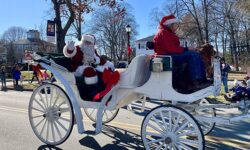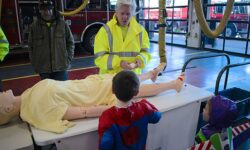The Walpole Footlighters recently celebrated their 100th anniversary with a gala party at the Olde Colonial Café in Norwood. Fittingly, the gala was held on April 13, which is Walpole Footlighters Day in the town of Walpole in perpetuity.
The Footlighters were formed in 1924 when Walpole High School Principal Frank Mansur convened a meeting with 12 other people already known for acting. The group decided to join forces to have more control over the acting they would otherwise be doing anyway for other groups. The first production was The Dover Road by A. A. Milne, who is better remembered as the author of the Winnie the Pooh stories.
The group performed at Walpole Town Hall in the early years, building sets at Charle Bean’s barn on Common Street or in the basement of the old Methodist Church and moving them to Town Hall just before the performances started. Funding was a perpetual issue. When the bank balance rose as high as $2.00, the funds would typically be spent almost immediately on lumber, nails, or other essentials of set building. The meager budgets did not hinder the group, as community support was enthusiastic. Founder Frank Masur acted in all of the group’s first 14 productions and wrote three of them himself.
After five years at Town Hall the Footlighters moved their performances to Walpole High School for the next ten years. As the stage was only available for two performances and a dress rehearsal (which often went until 3:00 AM before things went smoothly), sets were built at the Old Red Mill, now the site of the dam in Plimptonville. The group survived the Great Depression financially by selling tickets door to door when necessary.
After ten years at Town Hall the group persuaded Mrs. George Plimpton to allow the use of the Lewis Farm Barn for productions. The Footlighters had to build a stage and make a lot of changes to the barn to host plays, but the move allowed the group to increase the number of performances of each show from three to six. The number of productions had to be scaled back during World War II, but the shows managed to go on. By 1955 the Footlighters were recognized as an outstanding regional theater and invited to perform at the Boothbay Playhouse in Maine.
When the Plimpton family decided to sell Lewis Farm in 1951, the Footlighters had to look for another home. The financial issues were staggering until Charles Sumner Bird presented the group with a warehouse on the edge of Bird Park. Once again, the group had to convert a building into a theater and raise the money needed to do so. The result is the current Footlighters Playhouse at 2 Scout Road. The Footlighters are aware of how fortunate they are to own their own theater, which is unusual for a community theater. However, owning the theater means the group needs groom the grounds, fix or upgrade equipment, and constantly make repairs and improvements. Recent improvements include major roof repairs, a new furnace, upgraded wiring, a catwalk for installing and operating theatrical lights, a new air conditioning system, a sprinkler system, new restrooms including a handicapped accessible bathroom, and new seats (donated by General Cinema) , and most recently, a new oil tank.
As the Footlighters started their second century, they took a moment to look back with pride on the 290 productions they have mounted over their first 100 years. They have also started planning for the next 100 years. During their centennial season they started a long-term accessibility initiative with the hopes of making their productions more inviting for the vision- and hearing-impaired communities, among others. To learn more about the Walpole Footlighters, purchase tickets for an upcoming show, join the organization, or even make a much-appreciated donation, visit their website at www.footlighters.com.






















